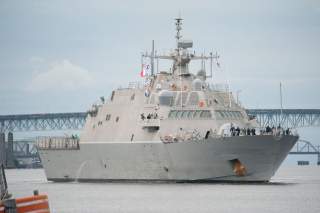I Ran a Simulated War in the South China Sea—and America Lost
Horror.
Still, they don’t do any appreciable damage to the already damaged ship — Griffin missiles have a warhead that weighs as much as two laptop computers. The next largest anti-ship missile in the American inventory, Harpoon, has a warhead that weighs 488 pounds. But there aren’t any Harpoons within hundreds of miles.
Finally, with the last of Freedom’s missiles expended, Changde goes down. But Quinzhou, the Type 056 corvette, has arrived at the shoal and engages Freedom with its 76-millimeter gun. Due to the short range of the 57-millimeter gun, Freedom can’t return fire.
I’m faced with a serious dilemma — at the edge of the range envelope of the Chinese gun, do I run and get away, or do I close with the enemy and destroy him?
At this point I release Halsey’s Hellfire-armed helicopter. It’s at risk of being shot down, but I have no choice if I want to save Freedom. It can’t sink Quinzhou, but it might inflict enough damage that would allow Freedom to get away.
I waffle, and Quinzhou and Freedom are now locked in a gun battle and only one is going to sail away. Freedom has a rapid firing gun and likely better fire control, but Quinzhou’s shells are larger.
Freedom catches fire. The ship begins flooding. Her gun are destroyed. I’m pulling her away, speed 41 knots, and praying Halsey’s helicopter arrives in time to cover her withdraw.
The game crashes. Instead of frustration, I feel relief. The a**-kicking has ended.
Postmortem
I was tempted to restart the entire scenario, but I quickly realized that no matter how many times I played it, the result was just going to be the same. The Littoral Combat Ships as configured were completely outclassed by their Chinese counterparts.
The worst part — the Chinese didn’t even have to use missiles to defeat the Americans.
Although small for their size, the Chinese ships packed a significant punch. Changde’s design dates back at least 20 years and weighs 1,000 tons less than the LCS, but it has eight anti-ship missiles and a 100-millimeter gun. The corvette Quinzhou weighs less than half as much as LCS, but had four YJ-83 anti-ship missiles and a 76-millimeter gun.
The Littoral Combat Ships had plenty of firepower … theoretically. Each had a 57-millimeter main gun, but these were woefully underpowered for attacking surface ships.
Each had 15 Griffin missiles, but the Griffins had a range even shorter than the gun. The missiles’ 13-pound warheads, while probably useful against Iranian speedboats practicing swarm tactics, were practically worthless against the Chinese.
Worst of all, in order to bring what meager firepower each had to bear against the enemy, the LCS had to bring itself within range of multiple Chinese weapon systems.
In our simulation, the Littoral Combat Ships were defeated. Is this an indictment of the LCS? It’s not that simple.
The LCS as we configured them — as U.S. Navy currently plans to configure them — were defeated. But the LCS is modular in nature, and the loadout of the anti-surface warfare module they carried could be changed.
If I had, for example, a mix of Griffin and Norwegian-made Naval Strike Missiles, I could have quickly destroyed both Chinese ships without things degenerating into a sword fight — where I had only a knife.
The 57-millimeter gun wasn’t really a problem, because I wasn’t supposed to be using it to engage other ships anyway. The decision that led me to use it in desperation against other ships was the problem.
The speed of LCS was useful, as I was able to push both ships forward at more than 40 knots. But as I was doing so, I couldn’t help but think that the gain of moving an extra 10 miles an hour was not really all that useful when a Chinese YJ-83 missile had a range of 186 miles.
I would have gladly traded the speed advantage of the LCS for the ability to sense and destroy Chinese ships at 187 miles.
There’s an inherent danger in reading too much out of commercial wargame simulations. As much as the game designers try to model modern air and naval warfare as accurately as possible, and that is exactly what Command’s designers did, the unknown unknowns, as Donald Rumsfeld would probably put it, could tip the scenario either way.
Warfare is tragic and unpredictable. Any difference in training, maintenance or secret capabilities of both navies — things we wouldn’t know until the shooting starts — could have decisively impacted the scenario.
Still, as the U.S. defense budget grows smaller and hard choices are being made, the dismal performance of the LCS’s anti-surface warfare module in our simulation is food for thought.
Do we want the Littoral Combat Ship to be able to tackle ships less than half its size, and if so, how do we get there? Because we’re certainly not there yet.
The LCS is the Navy’s handyman, capable of doing all sorts of jobs with its mission module system. Like all handymen, it has its toolboxes to get the job done. And few handymen are really, really good at everything you might expect them to do.
With all the potential missions for the Littoral Combat Ship and a limited pool of money, what do we expect it to do really well?
One things for certain — the handyman’s hammer is too small.
This first appeared several years ago.
Image: DVIDShub.

